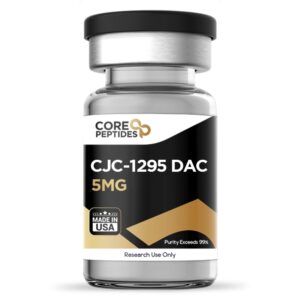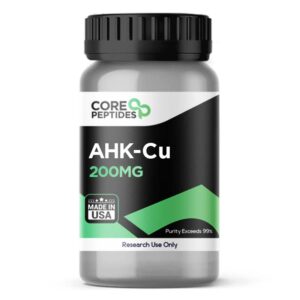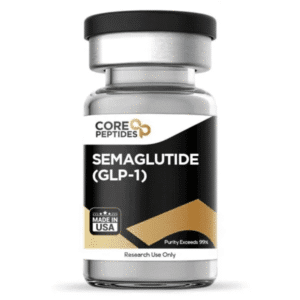Description
SS-31 Peptide (MTP-131) – Mitochondria-Targeted Research Peptide
SS-31, also known as Szeto-Schiller-31 or MTP-131, is a mitochondria-targeting tetrapeptide designed for advanced research into oxidative stress, cellular energy metabolism, and mitochondrial dysfunction. With a molecular formula of C₃₂H₄₉N₉O₅ and a molecular weight of 639.8 g/mol, this small yet powerful peptide features the sequence D-Arg–dimethylTyr–Lys–Phe–NH₂.
What makes SS-31 distinct is its strong cationic 3+ charge, enabling it to easily cross cell membranes and even the blood-brain barrier. Once inside cells, SS-31 selectively accumulates in the inner mitochondrial membrane, concentrating over 1,000 times higher than plasma levels. There, it binds with cardiolipin, a unique mitochondrial phospholipid essential for maintaining mitochondrial structure, cristae formation, and efficient ATP production.
By stabilizing cardiolipin and modulating cytochrome c activity, SS-31 may help protect mitochondria from oxidative damage, reduce the formation of reactive oxygen species (ROS), and enhance overall cellular energy metabolism. These properties make it a vital research tool in the study of age-related cellular decline, metabolic disorders, neurodegeneration, and mitochondrial pathophysiology.
Mechanism of Action
SS-31 exhibits high affinity for cardiolipin, which anchors it directly within the inner mitochondrial membrane. Its mechanism of action involves:
-
Preventing oxidative damage by inhibiting cytochrome c peroxidase activity.
-
Preserving mitochondrial cristae integrity for optimized electron transport and ATP synthesis.
-
Reducing ROS generation and supporting redox balance within cells.
-
Promoting energy efficiency in aged or stressed tissues through improved oxidative phosphorylation.
Through these pathways, SS-31 may restore mitochondrial function and protect cells from apoptosis, energy depletion, and oxidative stress—factors central to numerous degenerative and metabolic conditions.
Key Research Findings
1. Oxidative Stress and Retinal Health
In diabetic murine models, SS-31 demonstrated potential protective effects against oxidative stress by enhancing retinal barrier integrity, reducing markers of oxidative damage (8-OHdG, acrolein, nitrotyrosine), and improving the structure of retinal capillaries. These findings suggest SS-31’s possible value in oxidative stress and retinopathy research.
2. Aging and Cardiac Function
Studies in aged animal models found that SS-31 may reverse age-related oxidative modifications in cardiac proteins, improving mitochondrial and heart function. Its influence on redox balance and phosphorylation pathways suggests relevance in anti-aging and cardiovascular research.
3. Mitochondrial Dysfunction and Sarcopenia
Research in older subjects revealed SS-31’s ability to restore mitochondrial ATP production and enhance muscle performance, indicating potential applications in studies of muscle aging, sarcopenia, and energy metabolism.
4. Neuroprotection
SS-31 may protect neurons by reducing mitochondrial ROS, restoring superoxide dismutase (SOD) activity, and maintaining SIRT1 and PGC-1α expression—key factors for mitochondrial biogenesis. These mechanisms support its use in neurodegenerative and CNS research.
5. Metabolic Health
In type 2 diabetes models, SS-31 has been shown to reduce oxidative and ER stress in leukocytes, normalize autophagy markers, and improve cellular redox balance—making it an important compound for metabolic and inflammatory pathway studies.
6. Renal and Tissue Protection
By preserving mitochondrial cristae and supporting ATP recovery after ischemic injury, SS-31 demonstrated potential to mitigate acute kidney injury and promote tissue regeneration through mitochondrial protection.
7. Cachexia and Muscle Wasting
In cancer-induced cachexia models, SS-31 exposure was linked to enhanced ATP levels, improved mitochondrial function, and partial reversal of metabolic imbalances—highlighting its research potential in muscle degeneration and energy regulation.
8. Tendon and Cellular Repair
In tendinopathy research, SS-31 appeared to improve mitochondrial morphology in degenerative tenocytes and enhance antioxidant enzyme activity, suggesting roles in cellular repair and tissue regeneration studies.
Chemical and Structural Data
| Property | Details |
|---|---|
| Synonyms | Szeto-Schiller-31, MTP-131 |
| Molecular Formula | C₃₂H₄₉N₉O₅ |
| Molecular Weight | 639.8 g/mol |
| Sequence | D-Arg–dimethylTyr–Lys–Phe–NH₂ |
| Charge (pH 7.4) | +3 (Cationic) |
| Solubility | Water-soluble |
| Purity | >98% (HPLC verified) |
| Applications | Mitochondrial dysfunction, oxidative stress, neuroprotection, metabolic research |
| CAS | N/A (research use) |
Applications in Research
-
Mitochondrial function and redox studies
-
Neurodegenerative disease models (Alzheimer’s, Parkinson’s)
-
Cardiac and skeletal muscle aging research
-
Oxidative stress and metabolic syndrome studies
-
Kidney and tissue ischemia protection research





Reviews
There are no reviews yet.